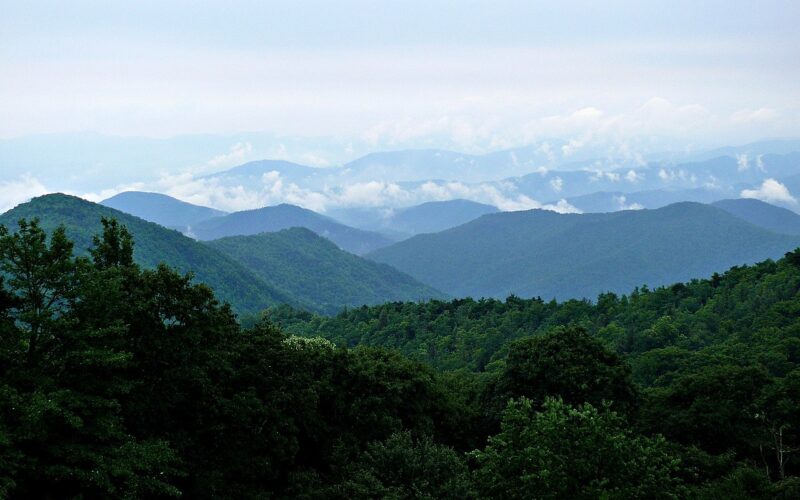The Blue Ridge Mountains are a majestic range of mountains that span across the eastern United States, from Georgia to Pennsylvania. The area offers stunning views and is home to a variety of rivers, lakes, waterfalls, streams, and an assortment of plant and animal life.
But what makes these mountains so unique and captivating is their distinctive blue color, which can be seen from miles away. In this article, we will explore the natural phenomenon that creates the blue haze that rests over the region, and how it has inspired generations of artists, poets, and storytellers.
Why Are They Blue?
The blue color of the mountains is not a result of reflection or refraction of light, but rather a phenomenon called Rayleigh scattering. Rayleigh scattering occurs when light waves interact with particles that are smaller than the wavelength of the light.
In this case, the particles are fine mists of volatile organic compounds (VOCs), which are emitted by the trees and plants that cover the region. VOCs are substances that can easily evaporate or change from a solid or liquid state to a gas.
Some examples of VOCs are terpenes, isoprene, and methanol, which are produced by coniferous and deciduous trees, respectively. When sunlight hits the VOCs, some of the light waves are scattered in different directions, depending on their wavelength and the size of the particles.
Blue light waves have a shorter wavelength and are more likely to be scattered by the VOCs than other colors. This means that more blue light reaches our eyes than other colors, creating the impression that the mountains are blue.
The effect is more pronounced when the air is humid and the sun is low in the sky, such as in the morning or evening.
What Do They Look Like?
The Blue Ridge Mountains are part of the larger Appalachian Mountains, home to the culture of the same name, which are among the oldest mountains in the world. The region is covered in many species of plants and is blanketed by thick forests, making it a very biologically diverse area.
Some of the common trees that grow in the region are oaks, hickories, maples, pines, hemlocks, and rhododendrons. The latter are especially famous for their colorful flowers that bloom in the spring and summer, adding more hues to the landscape.
The Blue Ridge Mountains have many peaks that rise above 6,000 feet, such as Mount Mitchell, which is the highest point in the eastern United States. The mountains also have many valleys, ridges, and gaps that create different microclimates and habitats for various animals.
Some of the wildlife that can be found in the region are black bears, white-tailed deer, bobcats, coyotes, foxes, raccoons, squirrels, chipmunks, and birds of prey. The region is also home to many endangered and threatened species, such as the red wolf, the Carolina northern flying squirrel, and the Virginia big-eared bat.
The Blue Ridge Mountains are also known for their scenic beauty and recreational opportunities. The region has many trails, parks, and attractions that cater to different interests and abilities.
Some of the popular destinations are the Blue Ridge Parkway, which is a 469-mile scenic drive that connects the Shenandoah National Park in Virginia and the Great Smoky Mountains National Park in North Carolina; the Appalachian Trail, which is a 2,200-mile hiking trail that passes through the region; and the Biltmore Estate, which is a historic mansion and garden in Asheville, North Carolina.
Cultural Phenomenon
The blue color of the mountains is not only a natural phenomenon but also a cultural and artistic one. The blue hue has inspired many people to admire, explore, and create works of art based on the region.
The blue color has also given the region its name and identity, as well as a sense of mystery and wonder. One of the earliest references to the blue color of the mountains comes from the Cherokee tribes, native to the region.
They called these mountains Shaconage, which means “the place of blue smoke”. The Cherokee believed that the blue mist was the breath of the Great Spirit, who watched over the land and its people.
The Cherokee also had many legends and stories about the mountains, such as the one about the origin of the firefly, which involved a brave warrior, a beautiful maiden, and a jealous chief. The blue color of the mountains has also influenced many artists, writers, and musicians, who have used the region as a source of inspiration and expression.
Some of the famous examples are the Blue Ridge Mountain paintings by Albert Bierstadt, the Blue Ridge novels by John Ehle, and the Blue Ridge songs by Dolly Parton, John Denver, and the Carter Family. The blue color has also been used as a symbol of nostalgia, longing, and homecoming, as well as a metaphor for freedom, adventure, and spirituality.
The Blue Ridge Mountains are a natural wonder that has captivated the hearts and minds of many people for centuries. They are a place where nature and culture meet, and where the blue color is more than just a visual phenomenon.
They are a place where the blue color is a part of the history, the identity, and the imagination of the region. They are a place where the blue color is nature’s paintbrush.
FAQ
When is the Blue Ridge Mountains’ blue color most vivid?
The blue color is most vivid during the late spring and early fall. During these seasons, the combination of atmospheric conditions and the angle of the sun enhances the blue hue, making it more pronounced.
Where are the best viewpoints for the Blue Ridge Mountains’ blue color?
Yes, some popular viewpoints include the Linn Cove Viaduct on the Blue Ridge Parkway and the summit of Brasstown Bald in Georgia. These locations offer panoramic views and the blue color is especially striking.
Does the environment affect the Blue Ridge Mountains’ blue hue?
Environmental changes, such as air pollution and climate change, can affect the intensity of the blue hue. However, conservation efforts help preserve the natural beauty and the distinct blue color of the mountains.
Can the blue color of the Blue Ridge Mountains be seen throughout the day?
The blue color is most noticeable during the early morning and late evening when the sun is low. Midday sunlight can diminish the intensity of the blue hue.
Are there events celebrating the Blue Ridge Mountains’ blue color?
Yes, there are several festivals, such as the Blue Ridge Music Festival and the Asheville Art in the Park, which celebrate the region’s natural beauty and cultural heritage, including the iconic blue hue of the mountains.
Is the blue hue visible in all seasons, including winter?
The blue hue is visible throughout the year, but it can be less pronounced in winter due to the absence of leaves on many trees and different atmospheric conditions. However, the winter landscape offers a unique and stark beauty of its own.
Final Words
The Blue Ridge Mountains, stretching from Georgia to Pennsylvania, are not only a natural marvel but also a cultural icon. Their unique blue hue, a result of Rayleigh scattering involving volatile organic compounds from the region’s lush vegetation, captivates onlookers and has inspired countless artists, poets, and storytellers.
These ancient mountains, part of the Appalachian range, boast a rich biodiversity and offer stunning landscapes filled with diverse flora and fauna. The blue mist, seen as the breath of the Great Spirit by the Cherokee, symbolizes more than just natural beauty; it represents a deep connection between nature, culture, and art.
The Blue Ridge Mountains stand as a testament to the awe-inspiring power of our natural world and the profound impact it has on human creativity and imagination.

